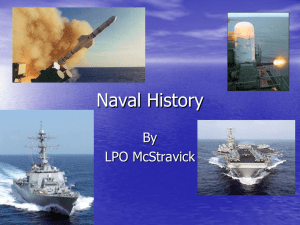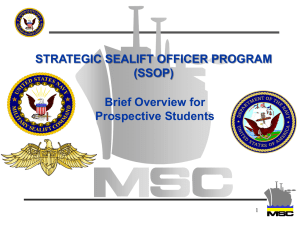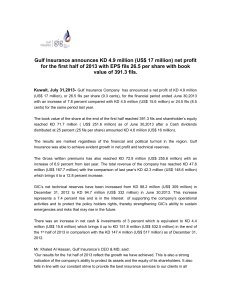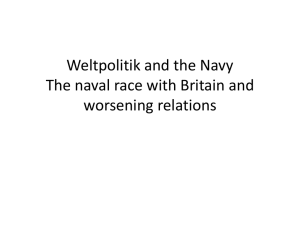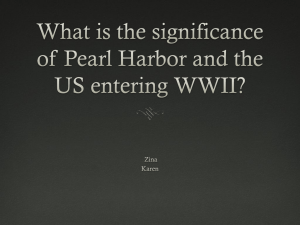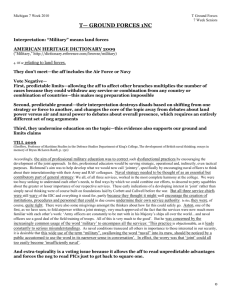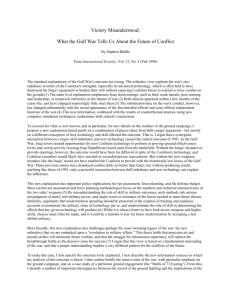5.16-U.S.-Navy-from-the-Maritime-Strategy-to-9-11-1980s
advertisement
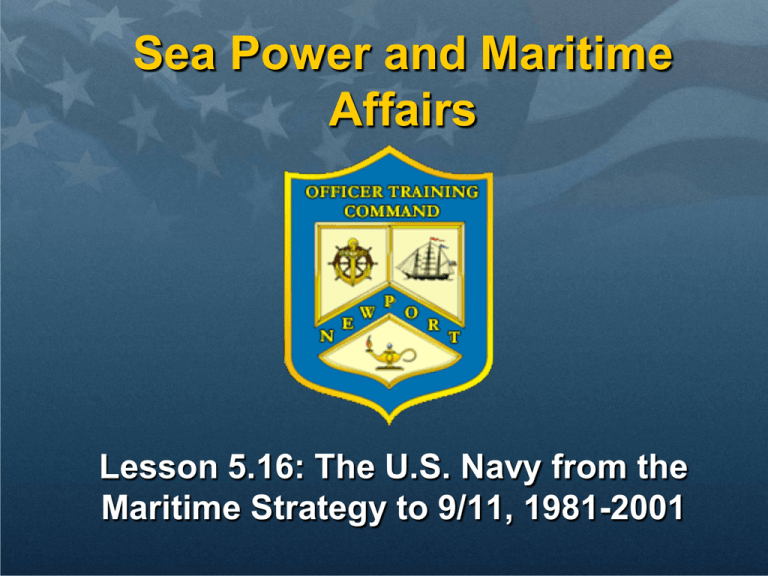
Sea Power and Maritime Affairs Lesson 5.16: The U.S. Navy from the Maritime Strategy to 9/11, 1981-2001 Enabling Objectives • Explain the policy goals of the Reagan defense buildup and the effects of increased military spending on employment of naval forces during the 1980s. • Know the essential elements of the “Maritime Strategy” of 1986. • State possible causes of the invasion of Kuwait and the U.S. reactions to it. • Define the military capabilities of the coalition forces and the Iraqi military after the invasion. • Describe the Navy and Marine Corps role in the different phases of Desert Shield and Desert Storm. • Describe the national strategic implications of the Post Cold War and its effects on policy and the Navy. The U.S. Navy Under Ronald Reagan, 1980-1988 • Soviets bent on world domination. We must build our military to combat communists and terrorists. Strategic Reorientation of U.S. Military • The U.S. would only fight when its national interests were clearly at stake. • U.S. would apply overwhelming force vs. limited force • Carl von Clausewitz’s “On War” Revamping U.S. Naval Strategy • SECNAV John Lehman, 19811987 – – – • A reserve naval aviator. Thought Navy was being dominated by engineers. Fired Rickover in Jan 1982. “Maritime Strategy” – – – – Offensive in nature. Goal: 600 ship Navy. Carrier battle groups were key. Designed to press home attacks against Soviet naval forces and homeland bases. Interventionism-Peacekeeping and Responses to Terrorism 1. 2. 3. 4. 5. 6. Grenada Beirut Bombing Gulf of Sidra attacks Operation “Eldorado Canyon” Tanker Wars Operation “Praying Mantis” Grenada and Beirut 12 October 1983 • Marxist overthrow of govt. • 600 U.S. medical students threatened. • 19 killed, 142 wounded. 23 October 1983 • Lebanese civil war. • 220 Marines killed. • Deadliest since Iwo Jima. U.S. Tangles with Libya, 1981 • 1973: Gaddafi proclaims a 12NM extension zone off it’s territorial waters. • “The Line of Death” - 62 NM • Aug, 1981: Reagan sends Nimitz and Forrestal to conduct FON. • Libyan jets fired on 2 F-14s inside Gulf of Sidra and are promptly shot down. U.S. Tangles with Libya…Again • March, 1986: USS America, Coral Sea, and Saratoga CVBGs conducting FON Ops. • CG and and two DDs crossed “line of death.” – Libyans fired on escorting U.S. planes. – U.S. responded by destroying a Libyan corvette and attacking missile sites. • 5 April 1986: La Belle bombing kills 2 U.S. servicemen and wounds 200. Operation EL DORADO CANYON, 15 Apr 1986 • USN and USAF airstrikes near Tripoli. • Navy planes strike SAM sites and hit Benghazi and Benina Airfield. • U.S. lost one F-111 and 2 pilots killed. • 37 Libyan dead and 93 wounded • America’s willingness to retaliate for acts of terrorism. The Tanker Wars • Iran-Iraq War from 1981-1988 • US agreed to escort Kuwaiti supertankers through Gulf. • 17 May 1987: Iraqi fighter fires 2 Exocet missiles into USS Stark (37 American dead) • 14 April 1988: USS Samuel B Roberts strikes Iranian mine which blasted a 21 foot hole in hull. – 10 Sailors wounded. Operation PRAYING MANTIS • 18 April 1988 – Immediate goal: destruction of two more Iranian oil platforms – In response, Iranian gunboats shot up nearby American flagged tankers – 270 neutral ships escorted through Persian Gulf (mines and shorebased Silkworms everywhere) The Immediate Post-Lehman Navy (1987-1991) • The Navy continued to be built around the big-deck carrier. • The Soviet Union Collapses – Berlin Wall torn down 9 Nov 1989 Battle History Video • Chapter 4 “Second to None” • Part a: Time 10:04 22:40 The Gulf War, 1990-1991 • 2 August 1990: 3 Iraqi RGFC divisions attack across Kuwaiti frontier. • U.S. Response: 2 August 1990, Carrier battle groups positioned to Persian Gulf and Red Sea. • U.S. would provide forces to defend Saudi Arabia and leave the Kingdom when it was done. The Coalition • United Nations coalition forces: – UN Resolutions passed requiring Iraqi withdrawal. • Nearly 50 countries – 38 countries with land, sea, air forces • U.S., U.K., France, Canada sent Navies • Gulf Co-op Council: Saudi, Bahrain, Qatar, UAE, Oman, Kuwait provided access and logistics. Operation Desert Shield/Storm U.S. National Policy Objectives: 1. Withdrawal of Iraqi forces from Kuwait 2. Restoration of Kuwait’s legitimate government 3. Security and stability of Saudi Arabia and the Persian Gulf 4. Safety and protection of the lives of American citizens abroad Iraqi Military Capabilities, 1990 • • • • 5k main battle tanks, 5k armored infantry vehicles, 3k artillery pieces. 400 Scud missiles 1 million regular troops. 4th largest army in the world Naval Role in the Gulf War • Maritime Intercept Operations (MIO) • Sealift - Maritime Pre-positioning Ships (MPS) – 95% of equipment came by the sea. • Six carrier battle groups (CVBGs) and two battleship battle groups (BBBGs) – Complete air and maritime supremacy. – Navy aircraft flew 1/3 of air missions. – 143 Iraqi naval vessels destroyed/damaged. – All northern Persian Gulf oil platforms secured. 20 Naval Role in the Gulf War • Battleships Wisconsin and Missouri – 16-inch guns to support ground troops. – First time 16’ guns were used since Korea. Marines and the Ground Campaign • 24-28 Feb -- 100 hour campaign • I MEF committed two Infantry divisions • I MEF took 8000 prisoners 20 miles into Kuwait by the end of day 1. • Kuwait airport secured by 27 Feb. 23 24 25 26 27 28 Conclusions • Estimated Iraqi losses – 100K soldier s dead, wounded and captured – 3847 tanks destroyed – 1450 armored personnel carriers destroyed. – 2917 artillery pieces and 32 aircraft destroyed. – 86,000 est. prisoners • U.S. Losses – 313 combatant and non combatant deaths • Importance of unity of command, power projection from the sea, and littoral warfare. • Ready land bases may not always be available • War reinforced the importance of the Navy-Marine Corps team for power-projection ashore Battle History Video • Chapter 4 “Second to None” • Part b. 22:40 - 34:06 Battle History Video • Chapter 4 “Second to None” • Part c. 34:06 - 44:34 Enabling Objectives • Explain the policy goals of the Reagan defense buildup and the effects of increased military spending on employment of naval forces during the 1980s. • Know the essential elements of the “Maritime Strategy” of 1986. • State possible causes of the invasion of Kuwait and the U.S. reactions to it. • Define the military capabilities of the coalition forces and the Iraqi military after the invasion. • Describe the Navy and Marine Corps role in the different phases of Desert Shield and Desert Storm. • Describe the national strategic implications of the Post Cold War and its effects on policy and the Navy. Questions? Next time: Lesson 5.17 The US Navy Since 2001

